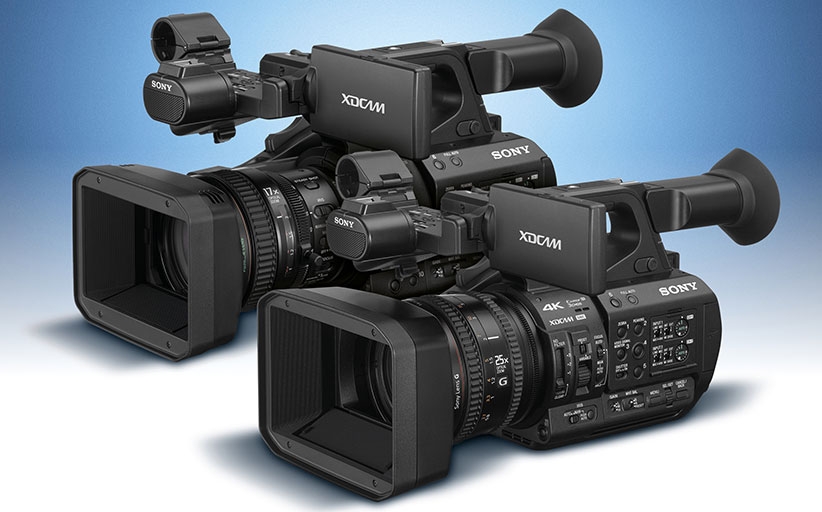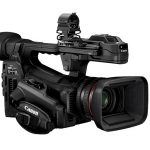
Sony’s triple-chip duo
Popular broadcast and streaming camcorder range enjoys tech update
Words & Images / Adam Duckworth
Not every filmmaker in the world wants the faff of a large-sensor camera and interchangeable, super-fast lenses that provide the cinematic-style ideal for dramatic productions. Shallow depth-of-field may look very Hollywood, but when you miss the focus of a news event, then it’s all for nothing. For broadcasting, streaming, ENG use and fast-paced work, an all-in-one camcorder is often the way to go. Sharp footage wins every time.
That’s not to say the potential buyer of a camera like this wants to compromise on image quality or the latest innovations, which can make a real difference to a camera’s usability in terms of both capture and delivery of footage. It’s easy to believe that the majority of manufacturers have focussed their development on cinema camera ranges while the camcorders have been left behind. And in some cases, that’s true.
Sony has poured all of its cinema know-how into two small-chip camcorders, unveiling a pair of Z cameras that are hailed as the first in the world to offer 4K from a three-chip set-up.
Instead of using a larger sensor to combat noise at high ISO, a three-chip camera uses three smaller sensors to separately record the red, green and blue information, which is then digitally combined to create a final image. This gives a vastly improved image quality and lower noise than using just one sensor of the same size. And it’s how manufacturers can get great quality from smaller sensors, which helps to create a greater depth-of-field.
The new Sony Z280 and Z190 cameras may be the first three-chip camcorders to offer 4K but have different sensor sizes. The Z280 is the top-of-the-range model and has half-inch CMOS sensors, while the more affordable Z190 is almost half the price and has third-inch CMOS chips and a lower spec, as you’d expect. It’s also slightly more compact and lighter.

But in many ways, they are both similar cameras and obviously designed by the same team that built Sony’s big-selling FS5 and FS7 cinema cameras. If you come from using either of these, then you’ll have no problem at all getting to grips with the Z cameras, as they share many of the same controls. The left side of the camera bodies have all the typical Sony controls, like menu buttons, lots of user-assignable buttons, push AF and proper audio control dials. Both have two record buttons – one on top and one on the handgrip. It’s a shame there’s not a third on the left side of the body, which would make it more useful when on a tripod.
“Both have two record buttons – one on top and one on the handigrip. It’s a shame there’s not a third on the left side”
The menu system in both cameras is also derived from the FS series, which means that if you are used to Sony then you will have no issue getting to grips with it. If you’re coming from another brand, then you’ll probably find it complicated and a bit fiddly.
Both cameras also have the variable ND filter system that was introduced on the FS5 and FS7 Mark II, and it is a glorious invention. In addition to hard stops of ND, the variable ND can be adjusted using a dial wheel or set to auto.
What this means is that you can keep your shutter speed and aperture constant for a desired depth-of-field and alter exposure using the ND wheel. If you are shooting news or documentaries, then the auto setting works incredibly well – especially if you are coming from outdoors to indoors, for example. The depth-of-field remains the same and the camera automatically changes the exposure by altering the ND value. It’s fast and simple.

Both cameras also have not one, but two of Sony’s Multi Interface (MI) shoes on top. These MI connectors allow you to attach two of Sony’s dedicated accessories like a wireless receiver or light, which work without any cables. You can’t use both MI shoes for audio, unfortunately, even though the cameras can record four channels. For that, you can use two channels via a single MI shoe receiver and two via the full-size XLR inputs on the right-hand side of the cameras.
There are even more similarities between the two cameras, such as using the BP-U style batteries from the FS series and the lenses having three separate control rings for accurate focusing, zooming and setting the iris.
Both cameras have an identical shutter speed range of 1/24-1/8000sec and a viewfinder screen that’s an 8.8cm (3.5in) LCD. The Z280 has an OLED viewfinder, which is very bright and detailed.
“All the buttons are in just the right place for handheld”
Both cameras have full LANC control support, plus HDMI and SDI for outputting footage. On the Z190, it’s the lower-spec 3G-SDI, while the Z280 has the higher 12G-SDI output, which is four times the bandwidth. So, to output 4K on the Z190, you need to go via the HDMI, because the SDI simply won’t cut it.
With similar spec, size and ergonomics, you’d expect both cameras to handle in a very similar manner – and they do. The Z190 has had its centre of gravity moved compared to its predecessor cameras (like the Z150) for a less top-heavy feel, and this works well. Both cameras balance nicely, all the control buttons are in just the right place for handheld, run-and-gun operations and the image stabilisation works smoothly on both. You can tell Sony has had decades of making cameras used by professionals in the field for many hours at a time.
There are many similarities between both cameras, but there are also significant differences in specs. The Z280 flagship essentially has a high-end codec that has an identical spec to the FS7 Mark II. It can shoot 4K 50p or 60p in XAVC-I, in 10-bit 4:2:2 at 600 Mbps. That’s an astonishingly high spec for a camcorder, but this obviously needs super-speedy media to record onto. So, the camera uses SxS memory cards. These cards are pretty much the fastest you can buy, but it’s unlikely many filmmakers will already have a supply of these. Even if you used them in earlier Sony cameras like the EX1, you’ll need bigger sizes to cope with the additional data from 4K. The latest, fastest 256GB SxS Pro+ spec card costs £1630/$1679.
You’ll also need to invest in a £258/$320 card reader, but thankfully Sony has introduced another way of downloading the data from the cards: there’s a USB port, which you can plug an external hard drive into. You then navigate the menus on the camera and instruct it to offload all the footage to the external drive. It’s a great option that means you can leave your camera downloading to a hard drive while driving back after a shoot, for example.
As an alternative to SxS cards, you can use XQD or even SD cards via an adapter, but you lose lots of speed and some functionality. The Z280 also shoots in XAVC-L and even MPEG-4, ideal for broadcast use. It can also output in the old DVCAM format, in case it needs to fit into a workflow that uses that legacy codec.
In comparison, the Z190 uses very cheap SD cards because it simply does not require such high data rates. It does record 4K in 50p or 60p, but not the gloriously colourful 10-bit 4:2:2. For those bit rates, it’s HD only.
And of course, with a larger sensor and 10-bit 4:2:2 4K, it’s obvious that the footage from the Z280 is a step ahead of the Z190 in terms of ultimate resolution and ability to suppress noise as you crank the gain up.
When you look at the 4K footage from the Z280, it’s hard to believe it’s from a sub-Super35 camera. It’s highly detailed, with natural colours and very low noise. There is plenty of information in the shadows and highlights, too. The noise at higher gain settings is there, but it’s unobtrusive and some noise reduction software can work wonders. And it can be graded to look virtually identical to files from an FS7.
The footage from the Z190 is also bright, punchy and detailed, but definitely a step behind the Z280 when you compare them side by side. But the reality is that few people will ever have the luxury of doing this like we did. And a potential purchaser will be impressed with the footage from the Z190, especially when shot in 4K in decent light.

(Above) Z190
The Z280 has an obvious edge in dynamic range, especially if you shoot in the flat S-Log3 colour profile. This is ideal for shooters who have time to spend carefully grading the finished film to get every bit of detail from the sensor and proves the Z280 can be used as more than just a run-and-gun ENG camera. It also has genlock, which allows it to be used as a studio broadcast cam, making it even more of a great all-rounder.

(Above) Z280
Images The Z190 footage is bright, punchy and detailed, but the Z280 has natural colours, with lots of information in shadows and highlights
“It’s ludicrous that such a massive zoom range is fitted to such an affordable camera. Wildlife shooters will rejoice”
The Z190 doesn’t have genlock or S-Log but, like its big brother, is HDR-ready, as there are several flavours of Sony’s Hybrid Log-Gamma (HLG) profiles installed. The Z190 is all about speed and using the camera as easily as possible to get broadcast-quality footage, whether outputting for standard dynamic range or HDR. The HLG footage from both cameras looks good when used on an SDR, Rec. 709 screen, although it does need a minor tweak in exposure. But it means your footage is future-proofed and ready for HDR use.
Another key difference is the zoom lens used on each of the cameras. The Z190 uses a Sony G series 25x optical zoom that’s a 3.7-92.5mm f/1.6 optic, which is the 35mm equivalent of a staggering 28.8-720mm. That’s wide at the wide end and very long at the long end. If you shoot in HD, it crops the 4K size sensor and the lens becomes a 50x zoom, equivalent to 1440mm. It’s ludicrous that such a massive zoom range is fitted to such an affordable camera. Sports shooters, wildlife shooters and news gatherers will rejoice.
The Z280 has a 17x optical Fujinon zoom. It’s a 5.6-95.2mm f/1.9 lens equivalent to 30.3-515mm. Again, in HD it doubles up to a 1030mm equivalent. Maybe not as wide or long as the Z190, but still hugely impressive, although the wider end is a bit of a compromise. The only way to go wider is to screw on an adapter lens.
The quality from both cameras’ lenses is impressive, with great control of flare, punchy results and no nasty vignetting or aberrations. It’s impossible to compare the two lenses empirically, as both cameras have different sensors, but they both provide excellent performance. Similarly, both lenses have triple control rings that are easy to use and give a very mechanical feel, even though they are electronically controlled.
While manual focus is the traditionalist’s chosen method of getting the image sharp, it’s in documentary use where autofocus can be very useful and has been a mainstay on cameras for many years. Both the Z190 and Z280 take this on in a big way, by using Sony’s own advanced AF system linked to clever face-detection technology that actually works incredibly well. There are face-detection AF and face-priority AF settings, where the focus locks onto any face in the scene and tracks it. Even if the person moves out of shot and back in, it quickly reacquires focus.
There is also face-recognition AF, where you can register someone’s face, then it recognises and tracks that face, even if other people are in the scene. It’s great for tracking a bride at a wedding, or an important person in a group of hangers-on. It even remembers the face after you’ve turned the camera off – freaky at first, but you soon get used to it. Once you’ve used it, it’s tough to go back to a camera that doesn’t offer it.
Of course, we are including these new cameras in our Livestreaming Special because they are both very suitable for livestreaming or TV broadcast – and even remote control via a smartphone. Sony’s Content Browser Mobile app lets you control your camera from a smartphone and then the footage can be sent to Sony’s cloud-based ENG server XDCAM Air, or uploaded via wired or wireless networks. The Z190 and Z280 have slots for two 4G dongles to allow streaming while out in the field without Wi-Fi or ethernet access.
They are ideal for recording fast-paced events, as well as getting top-quality footage out quickly or in real time in fantastic quality. This can be lower-res proxy media while the cameras store the highest-quality footage for editing later. Both Z cameras can be masters of many things.
“The quality from both cameras’ lenses is impressive, with great control of flare, punchy results and no nasty vignetting or aberrations”
The verdict
It may seem a bit odd to compare one flagship camera that costs £6939/$6950 to its little brother that’s far cheaper at £3750/$3750. However, both are aimed at the same sort of user. Both offer 4K from three-chip CMOS sensors, both are highly connectable (which makes them suitable for livestreaming), both are HDR-ready and both have spectacularly huge zoom ranges.
However, what you get for the extra money is the stunning FS7-like 4K 50p or 60p in XAVC-I, in 10-bit 4:2:2 at 600 Mbps, from larger sensors that the Z190 can’t compare to.
There’s also the very useful USB file output to an external hard drive, which might bypass the need for buying many of the pricey SxS cards. Add in the S-Log3 profile for maximum dynamic range and genlock for studio users and it’s clear to see why the Z280 is a much higher-spec camera and commands a premium. If you have a need for those features, then the Z280 is definitely a great choice that should give service for many years. It’s a workhorse camera that is solidly built and – with no interchangeable lens – you will never need to clean the sensor.
If you can live without the high and impressive spec, the Z190 is also a very capable camera, with stunning 4K footage and great low-light performance, although not quite as good as the bigger Z280. However, it’s not far behind and handles just as well.
If you want an all-in-one solution to fast-paced live event recording and live broadcast, you can’t go wrong with either of Sony’s Z cameras.
How they rate
| Features | 9/10 | Both cameras are packed with spec – no super slo-mo though. |
| Performance | 9/10 | Both cameras are designed to be a do-all solution and both deliver. |
| Handling | 9/10 | Sony knows how to build cameras for professionals and gets it right again. |
| Value for money | 8/10 | Both cameras do a lot for the money, but are not the cheapest on the market. |
| OVERALL RATING | 9/10 | If you know you need a fixed-lens camcorder, both new Sony Z cameras should be on your shopping list. |
Pros: Great AF, easy streaming, simple to use and stunning results
Cons: No super slo-mo, SxS media for Z280 is very pricey
Specifications
Sony Z190
Price: £3750/$3750 body only
Sensor: 3 x 1/3-inch back-illuminated Exmor R CMOS
Formats: XAVC-L, QFHD: MPEG-4 AVC/H.264, max
150 Mbps. XAVC-L HD MPEG-4 AVC/H.264, max 50 Mbps
Frame rates: 23.98 / 25 / 29.97 / 50 / 59.94 in QFHD and HD
Storage: 2 x SD
Lens: 25x optical zoom. 3.7-92.5mm/f/1.6 (equivalent to 28.8-720mm)
ND: Built-invariable ND filters plus three-stage optical ND
Output: BNC, 3G-SDI, HDMI, USB, ethernet, built-in Wi-Fi, FTP transfer and livestreaming
Shutter range: 1/24-1/8000sec
Screen: 8.8cm/3.5in LCD
Audio: Integrated stereo microphones, 2 x XLR inputs with phantom power support
Dimensions (WxHxD): 190x202x419.7mm/ 7.5x8x16.5in
Weight: 2300g/5lb 1.1oz, body only

Sony Z280
Price: £6939/$6950
Sensor: 3 x ½-inch back-illuminated Exmor R CMOS
Formats: XAVC-I, QFHD: MPEG-4 AVC/H.264, max 600 Mbps. XAVC-L, QFHD: MPEG-4 AVC/H.264, max 150 Mbps. XAVC-I HD MPEG-4 AVC/H.264, max 222 Mbps
Frame rates: 23.98 / 25 / 29.97 / 50 / 59.94 in QFHD and HD.
Storage: 2 x SxS slots
Lens: 17x optical zoom. 5.6-95.2mm/f/1.9 (equivalent to 30.3-515mm)
ND: Built-invariable ND filters plus three-stage optical ND
Output: BNC, 12G-SDI, HDMI, built-in Wi-Fi
Shutter range: 1/24-1/8000sec
Screen: 8.8cm/3.5in LCD
Audio: Integrated stereo microphones, 2 x XLR inputs with phantom power support
Dimensions (WxHxD): 178.4x202x426.3mm/ 7.1x8x16.9in
Weight: 2600g/5lb 11.7oz , body only

This feature originally appeared in the Spring 2019 edition of Pro Moviemaker.










